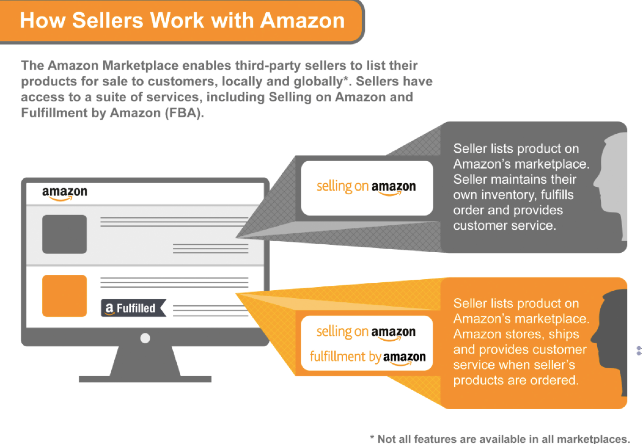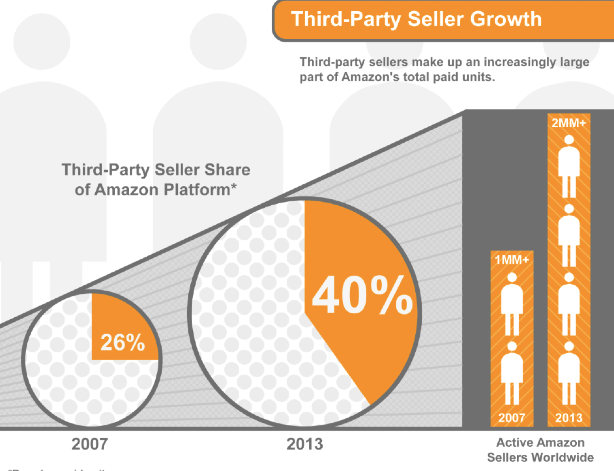When it comes to personalization, Amazon has been one of the pioneers in mining and using data to create a more curated e-commerce experience for consumers. But by now, nearly all e-commerce companies and marketplaces have caught on and are using more personalized recommendations to enhance the user experience when shopping and browsing.
Amazon has been particularly focused over the past few years on extending its personalization features for its sellers on the marketplace, both on the front-end consumer experience and on the backend.
We sat down with Peter Faricy, vice president and general manager of the Amazon Marketplace, to talk about how he and his team are approaching personalization for the company’s 2 million third-party sellers worldwide across 10 global marketplaces. Read our Q&A, which begins with Faricy providing some background information about Amazon Marketplace.
Peter Faricy: We have over 2 million sellers around the world selling across Amazon Marketplaces in 10 different countries around the world, and serving more than 200 million customers all over the world. So it’s that business that me and my team are responsible for. What we specifically do is we provide all of the technology and the products and services that sellers need around the world to run their business on Amazon.
So we are sort of your e-commerce engine, if you will. And the technology we develop helps them run their business on the Amazon Marketplace and reach customers and grow their business very successfully. So that’s kind of the quick background, if you will.
Leena Rao: So, one of the things that Amazon has been known for is being the pioneer of personalization and data mining to make the consumer shopping experience a much more curated type of shopping experience. So I am curious, sort of your view on this, and then how has that personalization strategy changed over time?
PF: Well, in the case of the Marketplace, we think about customers in two ways; we obviously think about the Amazon-buying customers and what they need and everything kind of starts with those customers in mind. But we also think of sellers on the Amazon Marketplace as our customers.
And sellers years ago began asking us questions around, what are the things that they can do to improve their business? How can they manage inventory better? What products should they be adding? How do they serve customers better?
So what I think you are referring to in this personalization, we developed some super-innovative technology three or four years ago that makes proactive, data-driven recommendations to each and every seller on the platform. And they range from suggestions on inventory quantities to new selections they should consider adding, to products they should consider fulfilling using a different surface than they use today.
We developed some super-innovative technology three or four years ago that makes proactive, data-driven recommendations to each and every seller on the platform.
And we have had great success with our sellers. We get a lot of positive feedback from developing these recommendations. And most of all, the way we kind of judge how helpful these are to sellers is how much they are used, and we know that sellers are actively using these recommendations to run and grow their business.
The part that’s been interesting for me is that it’s all self-service. So there is– when you mention how has it changed over time, we make every single day tens of millions of recommendations across all those different sellers. And on average a typical seller might have 100-plus recommendations in their queue in these different categories we have talked about before.
So we send them emails with recommendations. They can also take a look on our portal called Seller Central. On the Gateway page there is a platform called Selling Coach or Seller Coach and all the recommendations are also stored there.
And then we have many sellers that also plug into our business reports in different ways, and the recommendations are also available on our business reports. So we have got to serve up the recommendations in the manner that’s most effective for each seller, but try to give them the benefit of the data we have, our evaluation of their performance, and try to help make recommendations on what they can do to grow their business.
LR: When did you start doing this?
PF: Yeah, I think we started our first test in 2009, and probably went full-scale in 2010, and now it’s available in every country that we run a Marketplace in across the world, and every one of our sellers can access these recommendations.
LR: So what about the data and the signals you are using to help sellers personalize the Amazon experience for the end user, for me, who is, say, buying diapers on Amazon. How are you helping sellers then kind of draw the customer in through personalization?
PF: Yeah, I will try to give you a couple specific examples. I mean, as a customer one of the things that you rely upon is making sure that every product you are searching for is in stock.
And so sellers really value, they have told us, our guidance on when they are about to run out of stock and how much inventory quantity they should carry. And depending on the season of the year, particularly during the holiday season, it’s difficult to know how much inventory to have in stock, as the sales ramp up closer to the holiday season, in November, December.
So one example is that we give — one of our most popular recommendations is called straightforward enough, almost out of stock. So we take a look at how much you are selling; we take a look at the inventory that you have in stock on Amazon, and we make a recommendation based on what we think the forward-looking demand for your product will be, how much more you should add to inventory.
So that’s a super simple one, but honestly one of the most powerful ones for serving customers better, managing your inventory in e-commerce is very, very challenging, and sellers tell us they really find our recommendations useful.
LR: What are some of the other way’s that you are using data to kind of serve up additional recommendations which then brings traffic to sellers?
PF: When customers go to search for something on Amazon, and either they can’t find the product at all, which we call no search results, or the search results are of low relevancy, we have a way to measure how relevant the results are we return. We take that information and immediately surface it back up to sellers who already sell similar products and recommend that they also begin to carry these products that customers are looking for.
LR: It sounds like Amazon wants to go beyond just providing the kind of access around the stock or in the fulfillment, but also help them on the backend with their sales and business and things like that.
PF: Yeah, exactly, I think that’s a good way to say it. I mean, right now the most popular areas we are helping sellers on are things like inventory, which we talked about; helping them find new selection, new products to add to Amazon. We’ve got a lot of positive feedback on those recommendations.
Also, the fulfillment recommendations are super-critical, because we do offer a service called Fulfillment by Amazon, which is very popular with sellers, and some sellers choose to keep some inventory that they manage the fulfillment on their own. But for some of the more challenging inventory to fulfill for example, they may use Fulfillment by Amazon. And so we make recommendations based on the characteristics of how difficult these products are to fulfill or the seller’s own performance of doing a great job on serving customers and getting the products there fast and easily.
And so for sellers who have a more challenging time doing that we make recommendations in fulfillment. And then you know the area that’s been really growing quite a bit in popularity, is we are beginning to help sellers identify areas where they can improve the sharpness of their pricing.
So, for example, on the pricing world we surface up the sellers of all the different products you carry on Amazon, which of the products that you knot the lowest price on, and that allows them to go back and take a look at those products easily and determine whether or not it makes sense for their case to lower the price for customers.
LR: When it comes to social data, I am curious how sellers are responding to that sort of data when it comes to commerce. And do you feel like additional data from the customer is something that sellers are becoming more excited about?
PF: Yeah, I think, clearly “social” being a kind of a broad term certainly in an area that sellers understand how important that is to customers. And one of the ways that we try to connect customers and sellers on the Amazon detail page, is a new feature we introduced earlier this year called Ask, A-S-K, and you could see now, but if you go down some of our detail pages, we do something really interesting which is that we allow customers to ask a question about a product.
One of the things that our sellers love about selling on Amazon is they are really in complete control of their business.
Let’s say they are buying a camera and they want to know how good this camera is for shooting their children’s sporting events. And it’s kind of one of those questions, it isn’t exactly covered by the data that is provided about the camera, but it’s kind of a more “ask a friend” kind of a question. And we serve those questions up in an anonymous way to both the sellers of the items and also customers who previously purchased that item.
And so far we’ve had a great response rate. We’ve had answers come back very, very quickly and very, very thoughtful for people who already own the product or are selling the product.
So in the case of sellers who participate in this I think they have been pleased that they can, in this case, use kind of a more social angle to help customers find the product that’s best for them.
LR: Do you think that social data is something to allocate from Facebook, and are there different types of social data that work and some that don’t?
PF: Well, we don’t publicly discuss what kind of data we use for the recommendation, but certainly social data that’s publicly available like you are describing is certainly one of the inputs we use.
LR: From the sellers’ standpoint, Peter, how do you balance serendipity versus discovery? I think that a lot of sellers want, I am imagining, their product to be discoverable. How do you balance that need for discovery with also having millions of sellers on the platform?
PF: Well, one of the things that our sellers love about selling on Amazon is they are really in complete control of their business. So when it comes to these data-driven recommendations we allow them to opt in and opt out. We make over 50 different recommendations today and they can choose which recommendations we service up to them based on the ones that are most important to them or most important for their product.
We challenge ourselves and we measure how useful they are. We know the majority of our sellers actually use our recommendation today, because we measure and track that. Then we also track how much improvement to their business did they get from using our recommendation and we hold ourselves accountable.
LR: What would you say the most popular tool that sellers using when it comes to personalizion? using some of these personal additional tools you offer?
PF: The No. 1 is an email called the Almost Out-of-Stock email. So those words “Almost Out-of-Stock” are almost like their own brand in the seller world. So that still remains by far the most popular type of recommendation we make today, because you could imagine for sellers who either sell a lot of products in total or who are trying to manage their inventory through different types of seasonality or who are also trying to manage their inventory across multiple marketplaces. Many of our largest sellers sell on other marketplaces in addition to Amazon.
So they have a really big challenge to keep up with the demands of managing their inventory well. So, the “almost out of stock” set of recommendations, this has been the most popular.
But I will say what’s been increasing dramatically, is the appetite from sellers, and our ability to help them in adding new products to Amazon. And so we have millions of unique products at Amazon today and yet, I can tell you we have an opportunity to add millions more.
Our goal is to make it very easy for them to come join Amazon and very easy for [sellers] to make money, and we know that it’s really a win-win.
And so we surface up recommendation for sellers and we kind of do it in a way that’s smart and effective for them. So, if there is a seller who is selling lacrosse goals, and lacrosse sticks, and we notice there is an opportunity to add lacrosse jerseys and lacrosse balls, I obviously make those recommendations to them and so sellers really find, from the feedback they’ve given us, really find our selection recommendations to be really, really helpful and help them grow their business.
LR: What else is on a seller’s mind and what are you thinking about when it comes to future products?
PF: One of the things that sellers give us very positive feedback on is that we don’t charge sellers extra in order to receive these recommendations, and so you may see other participants in e-commerce taking other strategies here. But, we’ve for as long as the marketplace has existed, we don’t charge sellers listing fees and we don’t charge sellers fees for our recommendation.
So our goal is to make it very easy for them to come join Amazon and very easy for them to make money, and we know that it’s really a win-win. If we could help sellers to serve customers better, our customers will be happy, sellers will get to grow their business and of course that creates a great Amazon Marketplace.
So, the fact that this is a really innovative service free of charge I think is also kind of unique even in today’s world of e-commerce.
On the forward-looking front, I think without question there is a couple of topics that are on sellers’ minds; one is that many of them see the opportunity to grow their business beyond the current geography or country they are in.
So we’re beginning to make more and more recommendations for sellers on products they can sell outside their home country. And I think this is a game-changer, Leena, because if you think about the history of business, the only way you could experience it geographically was to maybe go plant the flag and open up a new office and add lots of capital and lots of overhead trying to figure out how to serve a new country. Being able to reach 10 countries on the Amazon Marketplace alone, plus customers from all over the world who shop those 10 marketplaces, is becoming a bigger and bigger opportunity for sellers. So that’s one.
And then I think the other is back to this topic of selection. I think there are a lot of interesting categories at Amazon that customers are really happy with and want to find more and more selection. And one example would be softlines; so clothing, apparel, accessories, shoes. That’s an area where we’re beginning to have really great customer experience, and we’re able to provide sellers with better and better recommendations of new products and new brands we love to see them add to the marketplace.

































Comment